First time fish owners must follow the below compilation of easy steps to enjoy a fuss free fishy experience.
Step 1: Selecting the right kind of fish
Beginners must opt for fresh water fish instead of the salt water ones. A few examples of fresh water fish that would perfectly suit first timers are Goldfish, Cichlids, Mollies, Minnows, Angelfish (not advised for beginners), Betta fish (may survive in a small bowl/Betta tank), Cory-Cats, Tetras, Sucker Cats, among others. Fresh water fish are considered to be suitable for amateur hobbyists as they are tough & enduring and its overall fish tank maintenance requires lesser time on part of the owner. On the other hand salt water fish require a special kind of care that can be a challenging task for the probable possessor. Saltwater aquariums require careful handling in terms of maintaining the salinity, restoring the evaporated water daily and maintaining the desired temperature apart from keeping it clean. The success of salt water tanks depends upon a combination of special techniques and fixtures. An important point to note here is that such an aquarium cannot be left unattended for more than 2-3 days.
Some small fresh water fish can easily survive without supervision for a week or slightly more as the water will not get dirty so fast owing to the size of the water baby and also an automatic feeder that will dispense healthy fish food such as flakes will take care of supplying the feed.
Step 2: Compatibility Factor needs to be considered
It is always a good idea to include more than one fish species in the fish tank. However care must be taken to acknowledge the compatibility between the species for maintaining a fresh water aquarium that is in top form, free of disease and any form of strain. For instance Mollies can co-exist with sucker-mouth cat fish, gold fish and tetras can be placed in the same aquarium.
Step 3: Deciding the size of the Fish Aquarium
Here the first thing to do would be to take note of the full size of the fish after attaining adulthood. This should be the basis of selecting an ideal sized tank. Even a single exceptionally small fish would require a minimum tank size of five gallon.
An undersized aquarium is deemed unfit for several reasons that can prove fatal for the survival of the fish in it. Suitable water levels permit the right PH balance (6.5 to 8.0) and temperatures. On the other hand a small tank would result in less water availability that in turn will lead to insufficient oxygen in the aquarium. Also fish continually bring out toxic ammonia that needs to be dealt with the right kind of filtration system. Therefore a big tank will enable proper installation of a filtration system and facilitate the aquarium nitrogen-cycle.
Did you know that a small tank can make your pet fish so stressed that it can succumb to death? The tank must be big enough to ensure that each fish in it has enough room to swim normally and move about without knocking into one another or the glass walls.
Step 4: Setting up the required Aquarium Apparatus
Create a bed of gravel at the bottom of the fish tank but remember to rinse off the gravel with fresh water before adding it. The gravel bed must be one to three inches in height depending upon the size of the tank. Inclusion of gravel is important as it offers a breeding spot for good bacteria. Attach an external air pump to an air bubble stone that can be strategically placed inside the aquarium. Fix the filter and make sure it functions properly. There are many different varieties available in the market these perform the task of dissolving the oxygen for it to go into the water for the fish to use. Once this is done put the heater into the aquarium. Place the thermometer and ensure a steady temperature between the ranges of 24 Degree Celsius to 28 Degree Celsius for your tropical fresh water species. Attach suitable lighting to the tank and cover the hood of the aquarium. Once the setting up is done run the apparatus for about 12 to 24 hours to ignite the natural cyclic process.
Step 5: Add the fish in the tank
Place only a few fish in the beginning. This will also help in the proper functioning of the filtration equipment without causing too much pressure on it. Feed your fish about thrice daily.
Step 6: Change 30% water weekly
Replace this water with fresh distilled water. Also one can use a gravel vacuum to pull out waste matter from the surface of the aquarium.
The water must be tested frequently for 0% nitrite & ammonia.
Step 7: Keep a watch on the Fish
The owner must constantly keep an eye on the fish in the Aquarium to check for any change in the color of fish, injury to the tail and damaged fins. Also separate the fish if you notice incompatibility issues.
Survival of the fish largely depends on a stress free atmosphere in and around the aquarium. Do not unnecessarily dip your hand in the tank or touch the fish. Also raising a ruckus near the tank is a strict NO.
Resource Box:
http://www.ebay.com/gds/4-Do-s-and-Don-ts-When-Buying-Tropical-Fish-/10000000177635459/g.html
http://www.wikihow.com/Take-Care-of-Your-Fish-(Tanks)
http://www.liveaquaria.com/general/general.cfm?general_pagesid=196
http://petskeepersguide.com/fish-tank-size-requirement/

